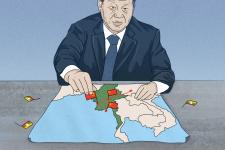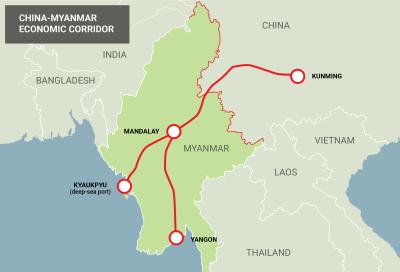John Nielsen

Myanmar is blessed as well as cursed by its geography. Sandwiched between Asia’s heavyweights, China and India, it is potentially in a favorable position for trade and economic relations with both countries. However, trade and economic relations are secondary to China’s geopolitical and security interests in Myanmar. China´s main objective in Myanmar is to gain access to the Indian Ocean through Myanmar and gain control over a dual-use deep-sea port in Kyauk Phyu on Myanmar´s west coast.
Another priority for China involves managing the stability of the two countries´ 2,000 km shared border. The porous border region has for decades played host to armed conflicts and is also the center of a billion- dollar drugs production and trafficking network. China regards Myanmar as forming part of its neighborhood, an extension of its national interests, and is extremely sensitive to any western engagement along its borders.
Access to the Indian Ocean
Gaining access to the Indian Ocean through Myanmar has been on Beijing´s drawing board since 1985 and has figured in the development plans of the Yunnan Province for years. It was part of China’s “Two-Ocean Strategy”, which focuses on ensuring access to the Indian Ocean and the Pacific in order to break with what China perceives as the encirclement of its borders. Since 2013, it has been a strategic objective of Xi Jinping’s Belt and Road Initiative (BRI).
While China seemed shell-shocked by the speed and depth of Myanmar´s leaning towards the west after 2011, Beijing was quick to take advantage of the international condemnation of the military’s persecutions and killings of the Rohingya minority. In November 2017, three months after the atrocities took place, Chinese foreign minister Wang Yi resumed talks with an internationally-weakened Aung San Suu Kyi and presented an outline for the “China – Myanmar Economic Corridor” (CMEC). As a Chinese diplomat expressed it “we found a more predictable partner in the civilian government than the military”, which Beijing never trusted.
The CMEC will encompass a transport corridor (roads, railroads, and economic special zones) stretching from Kunming in the Yunnan Province to Myanmar’s west coast, including a deep-sea port in Kyauk Phyu. The corridor aims to circumvent future conflicts in the South China Sea, which is increasingly contested, and offers an alternative to the narrow and congested Malacca Strait where the US has a strong military influence. Today, 80% of China’s imports of oil and gas, and most of its trade in goods, are shipped along these sea routes.
The construction of a dual-use deep-sea port in Kyauk Phyu is the crown jewel of the corridor project and the port could potentially cater to future deployments of the Chinese navy in the Indian Ocean. The transport corridor and trade with Myanmar will also offer China’s southwestern provinces energy security and opportunities for economic development.
Over the course of 2018, the Aung San Suu Kyi government renegotiated several agreements that previous military-led governments had made with China. A core group of advisers and economists managed to reduce the cost of the deep-sea port by almost 80% as well as increase the national share of the funding, thereby reducing the risk of ending in a debt trap in the same way as Sri Lanka and Pakistan. Aung San Suu Kyi also insisted that all subprojects had to follow international tendering procedures and should be open to international financial institutions rather than only Chinese credits. China reluctantly gave in to these demands in 2019 – 2020 and preparations to start the project were underway when the military coup of 1 February 2021 took most people by surprise.
Myanmar’s coup generals have resumed collaboration with China on various parts of the corridor projects as they again depend on China to shield them from international condemnations and to mitigate the effects of international sanctions. However, Myanmar´s military dictatorships had previously rejected the Chinese vision of a dual-use port . Relations between the Myanmar military and China have long been characterized by mutual distrust. The fiercely nationalistic Myanmar military is hyper-sensitive about sovereignty and has always been skeptical of China’s motives in Myanmar due to its continued support to Ethnic Armed Organizations (EAO) at its shared border.
Against that backdrop, it remains to be seen whether the military will provide China with access to a dual-use port that could potentially serve the Chinese navy. China might find that negotiations on the deep-sea port will prove to be more difficult with Myanmar´s military than they were with Aung San Suu Kyi´s quasi-civilian government.
Managing the shared border
Myanmar has faced ethnic divisions and conflicts along the China, India, and Thailand borders since gaining independence from British colonial rule in 1948. Several ethnic political movements and their armed wings have since fought for autonomy or federalism – a promise made prior to independence by the British and by Aung San, the main leader of the Burmese liberation movement.
After independence, the central government of Myanmar (then Burma) faced a Chinese-supported communist insurgency. However, in 1989 the Communist Party of Burma, which had a stronghold on the Chinese border, was dissolved, leading to the formation of new ethnic armies. Among those was the United Wa State Army (UWSA), which today is the biggest non–state army in Southeast Asia. Fueled by the drugs trade in the Golden Triangle and supported politically and logistically by China, the UWSA controls an area the size of Belgium in Shan State.
Based on a ceasefire with the military in 1989, the Wa was granted a self-administered area, where it has built up its own local administration based on the Chinese administrative model. It uses yuan as its currency, Mandarin is the dominant language, and the Internet is Chinese. Neither the Myanmar military nor the pre-coup civilian government have ever exerted real authority in the Wa area.
While the UWSA consolidated its territory after the ceasefire agreement in 1989, other ethnic armies along the Chinese border have regularly clashed with the military and its militias. Clashes are also occurring among some of the ethnic armies in the contested Chinese border regions. Chinese state and non-state groups, the Myanmar military, ethnic armies, militias and drug cartels are all fighting over territories and resources in northeastern Myanmar. This includes the drug production in the Golden Triangle and the illicit trade of jades, timber, rare earths metal etc.
 The China – Myanmar Economic corridor seeks to connect China with the deep-sea port in Kyaukpyu on Myanmar’s west coast and will provide China with direct access to the Indian Ocean.
The China – Myanmar Economic corridor seeks to connect China with the deep-sea port in Kyaukpyu on Myanmar’s west coast and will provide China with direct access to the Indian Ocean.Ensuring stability along the border will be an on-going priority for China, and Chinese business as well as state actors will continue to interfere in Myanmar’s domestic affairs to manage these conflicts and the economic underworld. This is a precondition for ensuring stable access for goods and services to the Indian Ocean and protecting the existing oil and gas pipeline.
By supporting some of the powerful ethnic armies, and by interfering in Myanmar’s decades-long peace process, China has effectively set aside its adherence to the principle of non-interference.
Keeping the west away from the neighborhood
China considers Myanmar part of its neighborhood, and therefore holds that the west, particularly the US, should not interfere. This has been made clear, quite openly, at all levels by the Chinese government.
Since launching the BRI, China has proactively involved itself in Myanmar’s internal peace process. Among others, it has employed a Special Envoy who has tried to facilitate talks between the ethnic armies and the Myanmar government while at the same time trying to prevent western countries from influencing the peace process.
Myanmar´s rebalancing towards the west, since 2011, and the stalled Myitsone dam project increased tensions between China and Myanmar, but China was back in the driving seat overnight after the military’s crackdown on the Rohingya minority in 2017.
The February 2021 military coup came as an unpleasant surprise to China. Chinese diplomats made no secret of the fact that the coup was not in China’s interest. Foreign Minister Wang Yi stressed on several occasions to Southeast Asian leaders that the region must find an ”Asian solution” to the conflict and that forces ”from outside” should not interfere.
In the present situation, where the outcome of the coup is still unclear, China has, under cover of international attention on Ukraine, stepped up its support for the military with a view to accelerating the BRI projects. Recent developments indicate that China is seeking support from its aligned ethnic armies, particularly the UWSA, to provide protection for its investment in the corridor project.
However, China is walking a thin line between supporting a military with limited public legitimacy and confronting a nationalist society with strong
anti-Chinese sentiments. China’s strategic objective of gaining access to the Indian Ocean could be jeopardized by attacks and sabotage on key infrastructure from the armed resistance groups (the People´s Defense Force) and the ethnic armies.
The geopolitical battle and the west
In the regional context, the establishment of a foothold for the Chinese navy on Myanmar´s west coast would lead to a redrawing of the security architecture around the Indian Ocean. In a not-too-distant future, the west might be looking into a scenario where China’s southwestern border is de facto drawn at what Chinese diplomats, in private, refer to as “our” west coast.
This scenario is a concern, not least for India, but it should also be a concern for the west. While the west has focused on a value-based democracy and Human Rights-based approach to Myanmar, both before and after the coup, China’s focus has been on stabilizing conditions to ensure the achievement of its geopolitical objectives. It is time for the west to engage more in the geopolitical perspectives of Myanmar´s development due to its unique geographical location and not only pursue a value-based approach.
No comments:
Post a Comment